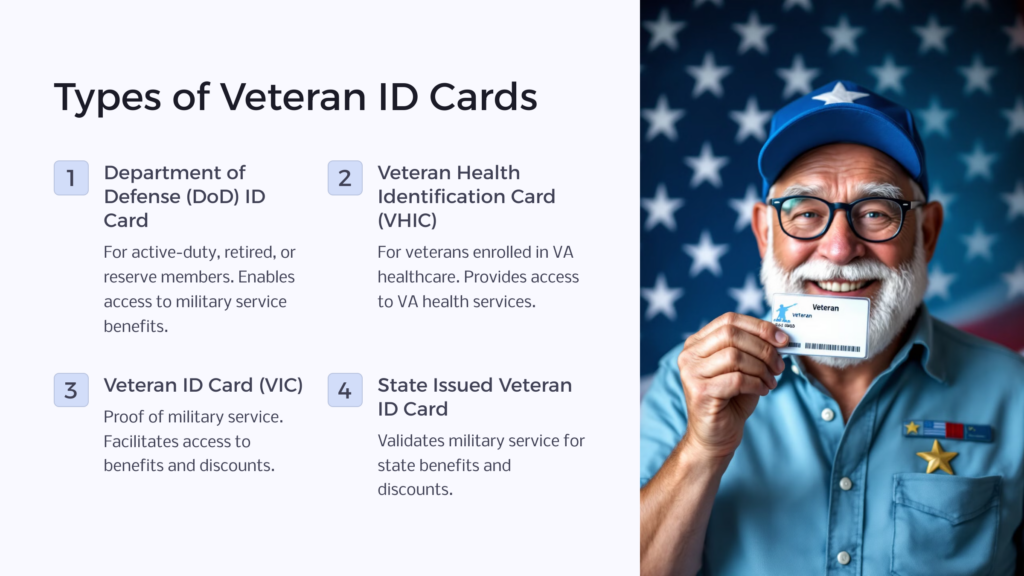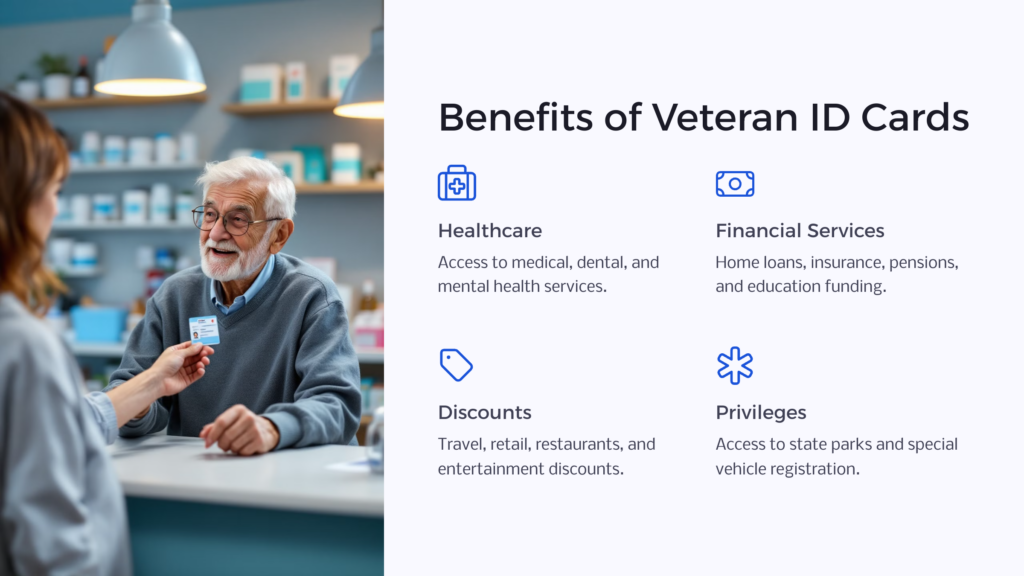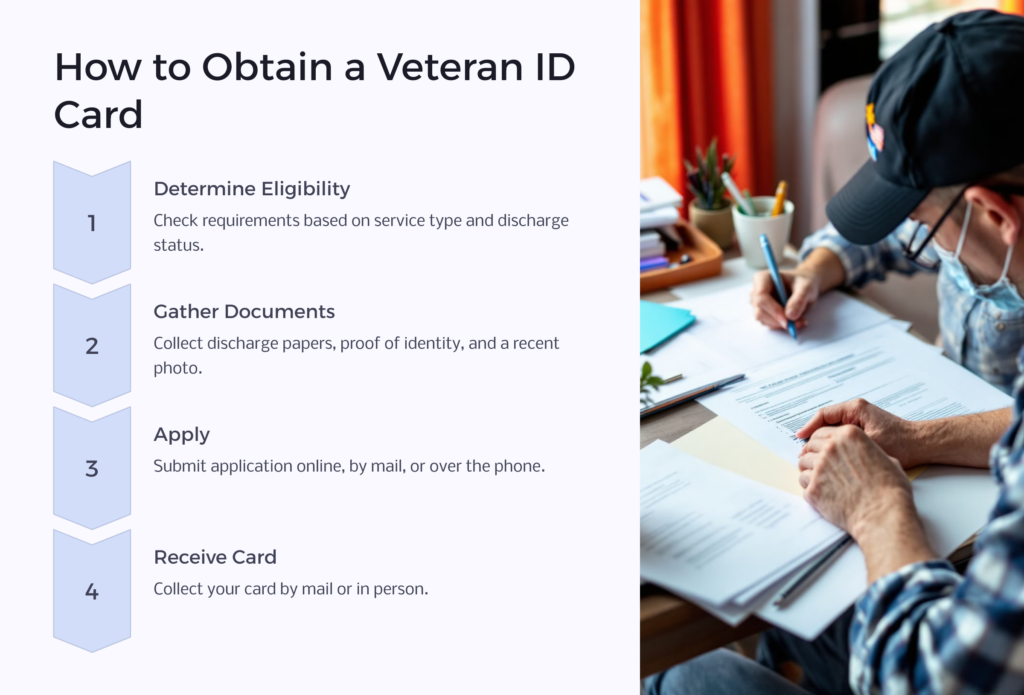The Veteran Identification Card, commonly referred to as a Veteran ID Card, represents more than a mere acknowledgement of one’s military service. This identification document is key to accessing a host of invaluable benefits and services exclusive to the veteran community. A Veteran ID Card is a tangible symbol of the respect, acknowledgment, and honor accorded to those who have served their nation with loyalty and dedication. In this article, we delve into the types of Veteran ID Cards, their accompanying benefits, the process of obtaining one, and solutions for commonly encountered roadblocks.
Part 1: Types of Veteran ID Cards

Veteran ID Cards come in various forms, with differing requirements and accessible benefits. It is essential to understand each card type to determine which best suits your specific situation.
1. Department of Defense (DoD) Identification Card
The DoD Identification Card serves military personnel, including veterans. In particular, it enables access to military service benefits and privileges.
Eligibility for this card extends but is not limited to active-duty, retired, or reserve members. Eligibility may also be extended to dependents in some circumstances.
2. Veteran Health Identification Card (VHIC)
The VHIC aims to provide veterans with seamless access to healthcare services from the VA. It also serves as proof of eligibility for veterans’ discounts.
To be eligible for a VHIC, you must be enrolled in the VA healthcare system.
3. Veteran ID Card (VIC)
The VIC serves as proof of military service in the armed forces. The card facilitates access to veterans’ benefits and services and can be used for discounts offered to veterans.
Eligibility for this card is extended to veterans who received an honorable or general discharge (under honorable conditions). Receiving a discharge under conditions other than dishonorable is also recognized.
4. State Issued Veteran ID Card
This card is provided by individual states to validate a person’s military service and provide evidence of eligibility for certain state benefits, services, and discounts.
Each state stipulates its eligibility requirements, generally including proof of honorable military service.
The Benefits of Having a Veteran ID Card

A Veteran ID card brings numerous advantages, serving as a bridge between the holder and a variety of benefits and services. These range from health and financial benefits to shopping discounts, services, privileges, and honors. Every card has a unique set of associated services. For instance, the VHIC provides access to VA healthcare services, while the DoD Identification card provides access to military benefits and privileges. Key benefits of the VIC and state-issued cards include their recognition for veterans’ discounts.
The opportunities accessed through a veteran ID are extensive, allowing former service members to tap into supports tailored to their needs and service history. Healthcare services span medical, dental, mental health, long-term care, and more. Financial services feature home loans, insurance, pensions, education funding, and compensation for disabilities incurred during active duty. Discounts apply to travel, hospitality, entertainment, retail shopping, restaurants, and groceries. Additional privileges cover everything from state parks access to vehicle registration. For veterans, these cards are a passport to aid and advantage as they transition back to civilian life. The cards open doors and smooth the road ahead across countless dimensions of life.
Expiration and Renewal
Veteran ID cards are issued by the VA to qualified veterans who have served in the US Armed Forces and been discharged under conditions other than dishonorable. The veteran ID cards have an expiration date printed on them, which is currently set at 10 years from the date of issuance.
When a veteran’s ID card is nearing its expiration date, they need to apply for a renewal by submitting a renewal application to the VA. The renewal application can be submitted within 6 months prior to the card’s expiration date. To renew, qualified veterans generally do not have to provide any additional documentation or proof of eligibility if their discharge status has not changed.
The VA does not charge qualified veterans any fees to apply for or renew a Veteran ID card. The ID cards and renewals are provided for free as a benefit in recognition of a veteran’s service. The only cost a veteran may incur would be to pay for new passport photos if they need to submit an updated photo, which is only required if their appearance has significantly changed.
In summary, Veteran ID cards expire after 10 years, veterans can renew them within 6 months prior to expiration by submitting a renewal application, no additional documentation is typically required, and the VA does not charge veterans any fees to apply for or renew the ID cards. This allows veterans to maintain a valid form of identification to access veteran benefits and proudly display proof of their service. Letting veterans obtain ID cards cost-free is a simple way to honor their military service.
Step-by-Step Guide on How to Obtain a Veteran ID Card

1. Determining Eligibility
The initial step towards obtaining a Veteran ID Card is determining your eligibility. This typically requires proof of your military service, type of discharge, and status (active, retired, reserve, etc.). Different cards have varying eligibility requirements, set by the issuing authority.
2. Gathering Required Documentation
The next step involves collecting necessary documentation. This usually includes a copy of your discharge papers or DD214, proof of identity such as a driver’s license or ID card, and potentially a recent photo for the ID card.
3. How to Apply
Applications for a Veteran ID Card can invariably be lodged online, by mail or over the phone. Each method demands adherence to a specific process—submitting forms, furnishing necessary documents, and following the step-by-step instructions provided by the issuing authority.
4. Collecting Your Card
After your application is approved, you’ll receive your Veteran ID card. The method of delivery depends on the issuing body, with options including mail or collection in person.
Part 4: Troubleshooting Common Roadblocks
The path to obtaining a Veteran ID Card may present several obstacles, such as eligibility doubts, document procurement issues, and application processing problems. Solving these typically involves reaching out to the VA, a veterans’ service organization, or the relevant state department.
Conclusion
Obtaining a Veteran ID Card is more than an exercise in due diligence—it’s a step towards accessing a host of benefits that deeply acknowledge your service, sacrifice, and dedication. Navigating through the different ID cards, determining eligibility, gathering documents, applying, and finally receiving your card may seem daunting, but each step brings you closer to accessing the aid, recognition, and respect you deserve.
Call to Action
If you are a veteran, take advantage of the benefits due to you. Begin the process of obtaining a Veteran ID card today. The journey might seem lengthy and arduous, but every step you take brings you closer to gaining acknowledgement, benefits, and services that honor your sacrifice and service. No veteran should be without this tangible symbol of their valiant service. Start your journey today!
 Benefits.com Advisors
Benefits.com Advisors
With expertise spanning local, state, and federal benefit programs, our team is dedicated to guiding individuals towards the perfect program tailored to their unique circumstances.
Rise to the top with Peak Benefits!
Join our Peak Benefits Newsletter for the latest news, resources, and offers on all things government benefits.



















